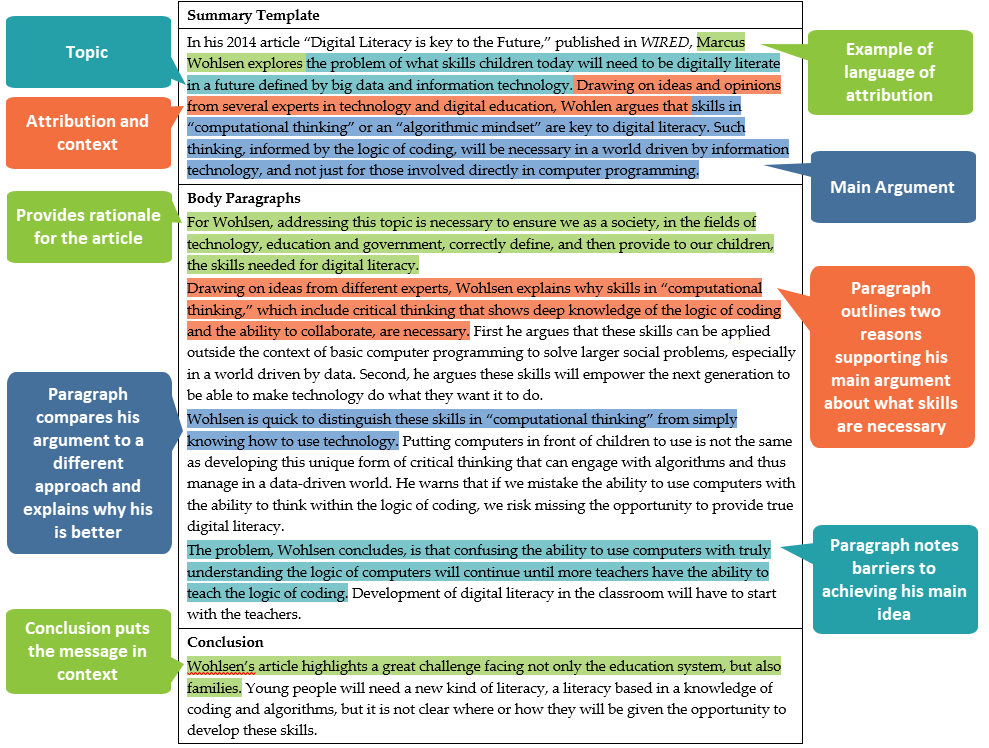In this Lesson, we will work to draft a well-written summary.
Note
This lesson is based on the article by Marcus Wohlsen:
Wohlsen, M. (2016). Digital literacy is the key to the future, but we still don’t know what it means. WIRED. Retrieved 14 April 2016, from http://www.wired.com/2014/09/digital-literacy-key-future-still-don’t-know-means/
If you haven’t already, you will want to read the article now.
You do not need to have completed Lesson B to enjoy this lesson. If you haven’t completed it, you can use the following resources to help you in this lesson:
This lesson provides 3 tips to help you produce the summary. First you will consider a suitable writing style for a summary. Next, you will consider the value of a language of attribution to introduce the author in the summary. And, finally, you will consider the conventional structure of a summary.
Writing Style
Once you have completed the reverse outline of an article, you are ready to write your summary. Remember, the purpose of a summary is to capture an article’s essential information in a clear and simple way. When we read your summary, we should understand the author’s main idea and have a basic sense of how that idea is developed in the article.
Focus on the following tips for writing style:
- Use short paragraphs to indicate the key ideas of the original article, capturing its main content.
- Try to capture how the article moved from point to point to develop its argument. You can represent the logical development of the argument by looking at the function of each key point.
- Write the summary in your own words and avoid quoting chunks of text from the original article.
Language of Attribution
While you are writing the summary in your own words, you still need to indicate that the ideas and arguments come from the author of the original article.
To do this, you will use attribution, which is a fancy way of saying you will indicate that the author is behind the ideas.
Compare these examples:
 |
We risk oversimplifying our understanding of digital literacy unless we define how and why our young people should learn to code. |
 |
Wohlsen states that we risk oversimplifying our understanding of digital literacy unless we define how and why our young people should learn to code. |
Because we are writing a summary of Wohlsen, we know that the idea belongs to him. But, the summary will be more effective and professional if we use a language of attribution throughout, indicating that all the ideas are his and not ours.
Structure
To write the summary, we can use the following Summary Template Reference. After you have completed a reverse outline, you will write the information up into proper sentences and paragraphs, remembering to use the language of attribution.
| Introductory Paragraph
Your introduction must include the following 3 components or features. (They can be combined into complex sentences.)
|
| Body Paragraphs
Develop your summary in short paragraphs. Generally, write one short paragraph for each of the key points, but these can be combined. For each paragraph on a key point:
|
| Conclusion
Write a short closing that reinforces the significance of the article.
|

Practice Writing a Summary
Let’s practice writing a summary of the Wohlsen article. Use your notes from the reverse outline to help you. If you need, you can use the sample answer for the reverse outline. When finished, compare your answer to the sample.
Using the template as a guide, write a summary of the Wohlsen article in the boxes provided.
